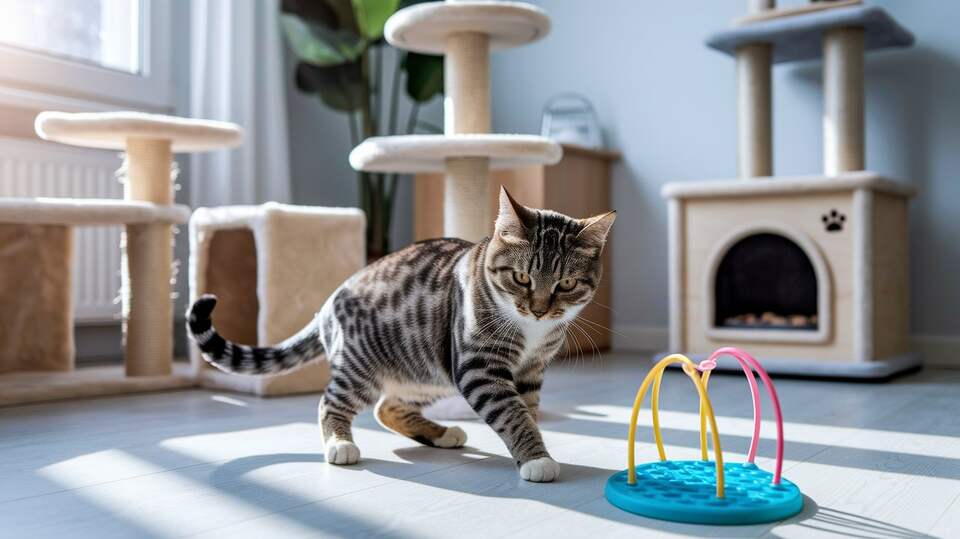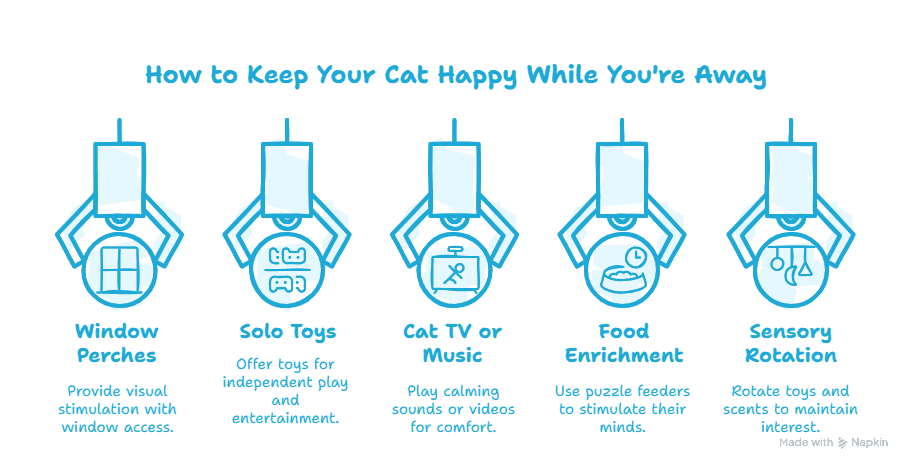
Introduction
Modern life is busier than ever. Between work, errands, social commitments, and (let’s be real) the occasional Netflix binge, it’s easy to feel guilty about not spending more time with your cat.
After all, cats are famously independent, right?
But here’s the truth: Even independent cats need stimulation, love, and attention.
The good news is—you don’t have to be home 24/7 to raise a happy, healthy, and well-adjusted feline friend.
In this guide, we’ll cover everything you need to know about how to keep your cat happy when you’re busy, without stress, guilt, or overcomplicating your routine.
Do Cats Get Lonely When Left Alone?
It’s a common myth that cats are totally fine being left alone for long periods. While cats may tolerate solitude better than dogs, they still need social interaction, enrichment, and consistency.
🚩 Signs your cat might be under-stimulated:
- Over-grooming or bald patches
- Destructive scratching
- Excessive meowing or clinginess
- Sleeping all day, then zooming all night
- Litter box issues or misplaced aggression
Your cat might not throw a tantrum when you leave, but subtle behaviors reveal how they’re really feeling. Just like people, cats can feel bored, anxious, or even depressed when left unstimulated for long periods.
What Makes a Cat Truly Happy?
Before we dive into tips, let’s define what a happy cat actually needs.
🧠 Mental stimulation
Cats are curious by nature. Boredom can lead to destructive behavior or depression.
🐾 Physical exercise
Cats need opportunities to climb, stalk, and “hunt” through play—even indoor ones.
📅 Predictability
A loose daily rhythm helps your cat feel safe and secure.
🧸 Safe independence
Your cat should be able to entertain themselves without relying on you 100% of the time.
Your Morning Routine Sets the Tone
You’re busy—we get it. But even 10 intentional minutes in the morning can mean the world to your cat.
✅ What to do before you leave:
- 5 minutes of active play (wand toys, laser pointer)
- Meal puzzle or slow feeder to engage their mind while eating
- Verbal interaction (“See you later, buddy!”)
- Leave interactive toys out and ready to go
- Give access to a sunbeam or window perch
This short burst of attention satisfies your cat’s social need and encourages them to settle down peacefully while you’re out.
How to Keep Your Cat Happy While You’re Away

This is where the magic happens—cat enrichment that works even when you’re not home.
🪟 1. Window Perches & Views
Cats love observing the world. Install a window perch where they can sunbathe, watch birds, or follow the rhythm of the day.
- Add a bird feeder outside for bonus “cat TV”
- Use shelves or a cat tree near a favorite window
- Rotate the view occasionally (different windows = new shows!)
🧸 2. Solo Toys That Actually Keep Them Busy
Not all toys are created equal. Some just sit there. Others keep your cat mentally and physically engaged.
Top options:
- Ball-and-track towers (great for batting practice)
- Treat-dispensing puzzle balls
- Motion-activated toys (battery-powered mice or flopping fish)
- Catnip kickers or crinkle tunnels
Pro tip: Rotate toys every few days to keep things fresh and exciting.
🎥 3. Leave on “Cat TV” or Calming Music
Some cats love ambient noise while you’re gone. You can try:
- YouTube “Cat TV” videos (birds, fish, slow-motion prey)
- Calming playlists (soft classical or nature sounds)
This helps reduce stress, especially for anxious or solo cats.
🧩 4. Food-Based Enrichment
Let your cat work a little for their food. This taps into their natural hunting instincts.
Try:
- Slow-feeding mats or bowls
- Stuffable toys with treats inside
- Timed automatic feeders (great for cats who meow at 5 am!)
It’s not just about nutrition—it’s about stimulation.
🌿 5. Scent and Sensory Rotation
Cats explore the world through their senses. Keep things interesting by changing up:
- Cat-safe herbs like catnip or silvervine
- New blankets or textures
- Scents from other rooms or safe outdoor items
Just make sure everything you introduce is safe and non-toxic.
Home Setup That Makes a Difference
A cat’s environment is everything, especially when you’re not around. Small tweaks can lead to big boosts in happiness.
🧗♂️ Create Vertical Space
Cats love to climb and perch.
- Add cat trees, climbing shelves, or window ledges
- Make sure they have both high-up and hidden spaces
- Let them observe safely from a distance if they prefer it
🛏️ Provide Cozy Hiding Spots
Some cats want a quiet, dark retreat.
- Cat caves, boxes, or even a shelf with a blanket
- Place these in low-traffic zones
🚿 Keep It Clean
Litter box issues can create stress, especially for solo cats.
- Scoop daily
- Use unscented litter
- Provide at least one litter box per cat, plus one extra
Tips for Working From Home Cat Parents
Being home all day doesn’t always mean more time with your cat. In fact, your cat might get confused if you’re around but ignoring them.
Here’s how to balance work and feline happiness:
💼 Structure “Cat Breaks”
Take 5- to 10-minute play or cuddle breaks between tasks.
Use this time to reward calm behavior, not demand meowing.
🚪 Create Independent Zones
Set up cozy spaces near your workspace but allow for separation.
Don’t reward constant interruptions.
🎯 Use Targeted Playtime
Interactive play sessions before AND after work hours burn energy and reduce boredom.
Evening Routine for Reconnection
Even if your cat did great while you were away, they still crave connection. Your evening routine matters.
🛋️ Try this:
- 10–15 minutes of play (chase, hunt, pounce)
- Brushing or grooming
- Cuddling or lap time (if your cat enjoys that)
- Verbal affection and eye contact
This isn’t just “making up for lost time”—it’s essential to reinforcing your bond.
Signs Your Cat Is Happy (or Not)
😺 Signs of a Happy Cat:
- Bright eyes and responsive body language
- Eating and grooming regularly
- Using the litter box consistently
- Napping in favorite spots
- Kneading, head-butting, or playful behavior
😿 Signs Your Cat Might Need More Stimulation:
- Over-grooming or chewing fur
- Hiding or lethargy
- Unusual vocalizing
- Clinginess or aggression
- Destructive scratching or eliminating outside the box
If you notice these signs, it may be time to adjust their enrichment plan, or check in with your vet.
What If You’re Away for Long Periods Often?
If you travel or work long hours consistently, consider:
- Hiring a pet sitter for visits
- Using a trusted friend or family member for interaction
- Adopting a second cat (but only if your current cat enjoys companionship)
Just remember—some cats thrive solo. Others truly need a buddy. Assess carefully before adding another animal.
FAQs
Is it okay to leave my cat alone for 8–10 hours a day?
Yes—if their environment is enriched and their needs are met. Make sure they have access to food, water, a clean litter box, and safe entertainment.
What’s the best toy to keep my cat entertained while I’m gone?
Puzzle feeders, motion-activated mice, and ball towers are top picks. Every cat is different, so experiment!
Should I get a second cat to keep my cat company?
Only if your cat enjoys feline company. Some cats prefer being solo. Always introduce new cats slowly and with proper supervision.
How much daily playtime does my cat need?
Aim for two 10- to 15-minute interactive sessions per day, especially if your cat is young or energetic.
Also Read - How to Train a Cat to Stay Off the Counter?
Conclusion
You don’t need to quit your job or feel guilty every time you leave the house.
You absolutely can keep your cat happy—even when life gets hectic.
By building a stimulating environment, offering independent entertainment, and staying consistent with bonding routines, you’ll give your cat the joyful, enriched life they deserve.
Because at the end of the day, happiness for your cat isn’t about having you home all day, it’s about feeling loved, secure, and engaged, no matter how busy you are.




